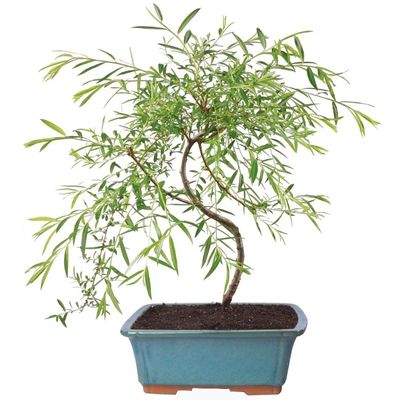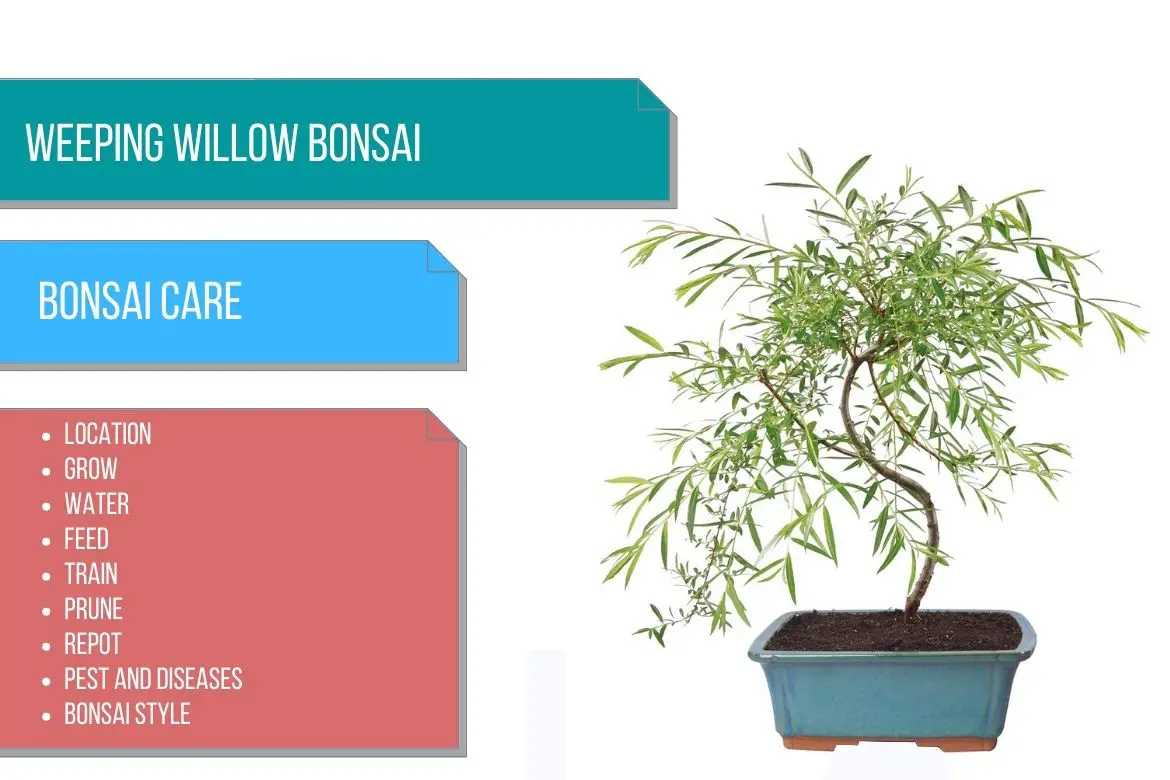
Weeping willow
(Salix Babylonica)
Country of Origin : China, Japan, Korea
Bonsai Styles : Multi-trunk, Informal style, cascading style, Mame
Zone : 4 – 10
Weeping willow is a vigorous, fast-growing, hardy deciduous tree.
The tree produces long, lanceolate, and slightly serrated leaves. Leaves are mid-green on top and grayish underneath. Additionally, it produces silver-green catkins in the spring.
Usually highly colored, the shoots grow very quickly and produce their leaves alternately in a spreading rather than compact arrangement.
The stems of weeping willows tend to be red, which makes the tree more appealing when displayed just after the catkins appear.
Can you bonsai a weeping willow?
Yes. Weeping willow makes for an easy to train impressive bonsai. This is one of the few trees that can be trained into a weeping style. Weeping willow bonsai is suitable for multi-trunk, informal upright and cascading bonsai styles. However, one thing must be kept in mind: when planted in a pot, the branches of the weeping willow will not droop naturally. Hence there will be a need for training them to point downwards.
How long does it take a weeping willow bonsai to grow?
The answer to this depends on whether you are growing the young seedling (from cutting) in a pot or on the ground. If you are growing the seedling in a pot, I would suggest a big flower pot. In 2-3 years you will see a big plant. However, I’m almost certain that you will not be happy with the thickness of the trunk. (Despite all the pruning techniques for thickening the trunk)
Hence, I recommend growing the tree on ground first. In almost 3 years you will get a big tree with a thick trunk. This tree can be easily pruned and trained to make a beautiful bonsai. To get an even thicker trunk, keep a sacrifice branch on the lower part of the tree and prune rest of the branches.
Read more about other bonsai trees species in : Types of bonsai tree
Best location to keep Weeping willow bonsai tree
Bonsai can be grown in full sun throughout the growing season. During really hot summers, you can keep the bonsai in partial shade.
Although it does not require special protection in winter, ensure that the tree is protected from prolonged periods of extremely cold weather.
The tree thrives in well-aired areas.
Can a weeping willow bonsai be kept indoors?
No. Weeping willow is an outdoor bonsai tree. Some growers even leave their Willow bonsai in the open ground for most of the year. They pot it into its bonsai pot in early spring so that its fresh foliage can be enjoyed. After that, they put it back in the ground until the following spring.
IMP: Refer to do bonsai trees need sunlight for more indoor and outdoor bonsai location ideas. Also, refer sunlight requirements for indoor plants for more indoor gardening ideas.
Propagation of Weeping willow bonsai tree
Normally, seeds ripen between late spring and early summer and germinate immediately after they have been sown. Sow the seeds in damp soil, preferably sandy soil. After two years from the time of planting, the seedlings should be repotted.
Can a weeping willow grow from a cutting?
Yes. Weeping willows can be grown from a cutting. The branches readily produce roots. Summer is the best time to take soft cuttings. Plant the cutting in a peat-sand mixture and keep the soil moist. You can even place the cutting in water and then plant it in a pot after sufficient rooting has taken place.
Weeping willow cuttings can even be propagated in the spring. (when the buds are just opening).
Watering Weeping willow bonsai tree
Like all willows, weeping willow bonsai trees are very thirsty. The bonsai soil has to be kept consistently moist. However, do not waterlog the soil.
Don’t be surprised if you find yourself watering the plant twice a day in hot summers. Keep the bonsai pot on a tray of water throughout the summer.
You can also try the immersion method to wet the bonsai soil.
During the winter, keep the soil moist.
The tree needs a high level of moisture, so spray water on it thoroughly. This will also protect the tree from pests, and clean the leaves of pollution. During the growing season, spray frequently.
Read watering bonsai tree for more details and also about bonsai water immersion technique.
Wiring Weeping willow bonsai tree
After the new shoots have reached the desired length you need, wire them to mimic a weeping effect. You can wire the branches throughout the growing season.
You can even use weights to get the desired effect. However, I must add that training a bonsai by using weights is not as accurate, reliable and fast.
You can use raffia to protect the tree from scarring. Watch wires closely because this species grows rapidly.
Leave the wires on for the growing season. Wiring will be an annual exercise with this tree.
Read : Detailed guide on How to wire a bonsai. This extensive guide includes all the wiring techniques and Do’s and Dont’s. It will also show you other bonsai training techniques which can be achieved without using wires.
Pruning Weeping willow bonsai tree
When to prune Weeping willow bonsai tree?
How to prune Weeping willow bonsai tree?
To keep the foliage compact and close to the trunk, heavy pruning is necessary every year.
In order to train the new shoots to hang down, the old branches need to be pruned early in spring before the sap begins to circulate. Each spring, willows should be pruned hard. The previous season’s untidy growth should be trimmed back.
As new shoots emerge, pinch back their growing tips so that only one leaf node remains. This should be done throughout the growing season.
Read how to prune a bonsai to know about the right technique of pruning and more about defoliating a bonsai tree.
Repotting Weeping willow bonsai tree
When to repot Weeping willow bonsai tree?
Weeping Willow trees have a spreading root system that grows rapidly. Sometimes they can even break the bonsai pot.
Weeping willow bonsai trees must be repotted frequently to avoid the roots being pot bound. Spring and midsummer are good times to repot.
One sign that the roots are pot bound is that the tree will lose vigor.
In fact, the root system grows so vigorously that it is not uncommon to have to repot the bonsai twice a year. (Probably one of the very few bonsai species that needs such repotting practice)
As a general rule, repot young weeping willow bonsai trees every year. Mature bonsai trees older than 5 years can be repotted every second year.
However, this is just a general rule. Follow a routine of checking the roots every spring to see if the tree needs repotting.
Heavy pruning should be done in the spring before repotting. You can prune half the root system.
Use a deep pot to plant the bonsai tree. In order for the willow to thrive, the soil must be moist, marshy, light, and cool.
Use a moisture-retentive but free-draining Bonsai soil mix.
You can also use sand or fine gravel, leaf mold, and loam in the ratio of 1:1:1.
Please check out how to repot a bonsai to know everything about repotting and root pruning a bonsai.
Must Read: Bonsai Soil Recipes
Must read : Choosing the right bonsai container
Feeding Weeping willow bonsai tree
Apply feed in the spring and fall. Use organic fertilizer that is slow-acting. A single feed application once a month should be enough.
Do not feed the tree after repotting or in midsummer.
Read more about bonsai fertilizer and its application.
Diseases and pest of Weeping willow bonsai tree
Weeping willow bonsai trees are prone to scale insect attacks. You can apply tar oil spray (e.g., liquid malathion) in January or during the growing season.
Aphids can also cause problems with this bonsai tree. Try to remove these pests manually or use a systemic insecticide.
As soon as you notice caterpillars on your plants, remove them by hand as quickly as possible. They can defoliate a plant quickly.
Anthracnose disfigures and kills new leaves. The infected leaves will have brown spots on them.
Mildew and honey fungus can also pose problems for the tree. The leaves and shoots that have been affected should be removed and burned. Spray some copper fungicide on the tree.
Our comprehensive guide: How to identify and treat bonsai pests and diseases is a great resource for you to see all the organic and inorganic remedies you can use.

